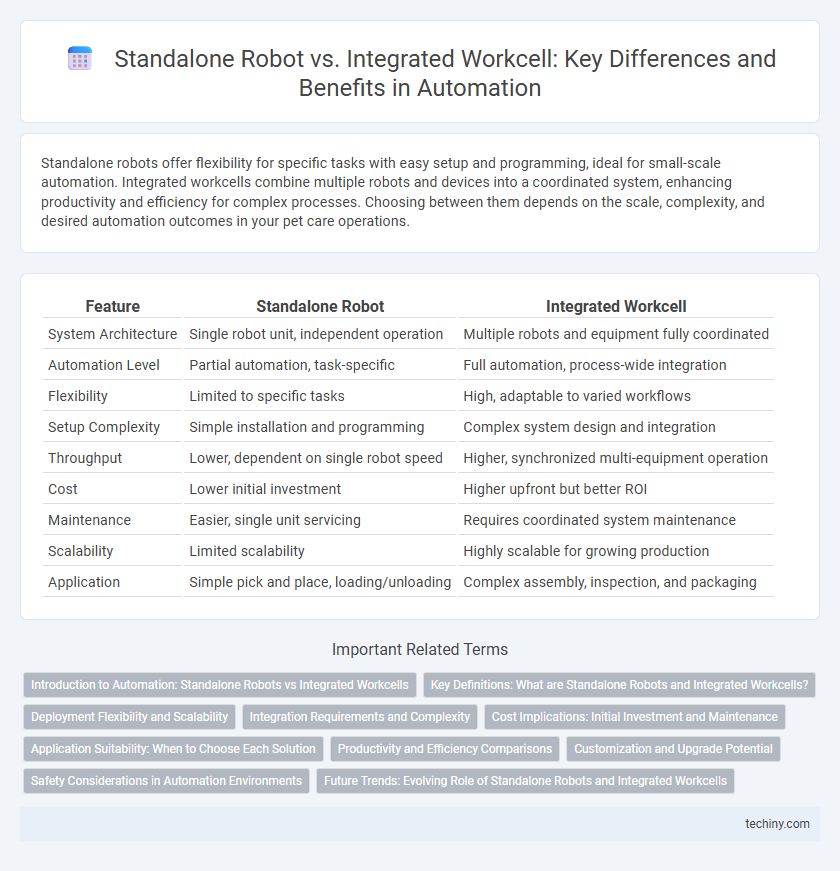Standalone robots offer flexibility for specific tasks with easy setup and programming, ideal for small-scale automation. Integrated workcells combine multiple robots and devices into a coordinated system, enhancing productivity and efficiency for complex processes. Choosing between them depends on the scale, complexity, and desired automation outcomes in your pet care operations.
Table of Comparison
| Feature | Standalone Robot | Integrated Workcell |
|---|---|---|
| System Architecture | Single robot unit, independent operation | Multiple robots and equipment fully coordinated |
| Automation Level | Partial automation, task-specific | Full automation, process-wide integration |
| Flexibility | Limited to specific tasks | High, adaptable to varied workflows |
| Setup Complexity | Simple installation and programming | Complex system design and integration |
| Throughput | Lower, dependent on single robot speed | Higher, synchronized multi-equipment operation |
| Cost | Lower initial investment | Higher upfront but better ROI |
| Maintenance | Easier, single unit servicing | Requires coordinated system maintenance |
| Scalability | Limited scalability | Highly scalable for growing production |
| Application | Simple pick and place, loading/unloading | Complex assembly, inspection, and packaging |
Introduction to Automation: Standalone Robots vs Integrated Workcells
Standalone robots operate independently, performing specific tasks with programmable precision but limited interaction with other systems. Integrated workcells combine multiple robots, machinery, and control systems into a cohesive unit that enables synchronized operations and higher productivity. Choosing between standalone robots and integrated workcells depends on production complexity, scalability needs, and workflow integration for automation efficiency.
Key Definitions: What are Standalone Robots and Integrated Workcells?
Standalone robots are autonomous robotic units designed to perform specific tasks independently without the need for additional machinery or systems. Integrated workcells combine multiple automated components, including robots, conveyors, sensors, and control systems, to create a synchronized production environment that enhances efficiency and flexibility. Understanding these foundational definitions is crucial for selecting the appropriate automation strategy in manufacturing and industrial applications.
Deployment Flexibility and Scalability
Standalone robots offer high deployment flexibility by being easily relocated and reprogrammed for diverse tasks, making them ideal for small-batch production. Integrated workcells provide superior scalability through seamless integration of multiple robots, conveyors, and sensors, enabling complex automation processes and increased throughput. Companies seeking rapid adaptation with minimal infrastructure changes prefer standalone robots, while those aiming for long-term production expansion invest in integrated workcells.
Integration Requirements and Complexity
Standalone robots require minimal integration efforts and can operate independently with basic programming, making them suitable for simple, repetitive tasks. Integrated workcells demand complex systems integration involving coordinated communication between multiple robots, sensors, and conveyor systems, increasing the need for advanced software and control architectures. The complexity of integration directly impacts deployment time, maintenance, and scalability in automated manufacturing environments.
Cost Implications: Initial Investment and Maintenance
Standalone robots typically require lower initial investment but may incur higher long-term maintenance costs due to limited integration and flexibility. Integrated workcells demand a higher upfront expenditure, incorporating sensors, conveyors, and control systems that enhance automation efficiency and reduce downtime. Over time, integrated workcells often deliver better return on investment by minimizing operational disruptions and maintenance expenses.
Application Suitability: When to Choose Each Solution
Standalone robots excel in applications requiring high flexibility and rapid deployment, ideal for tasks like pick-and-place or simple assembly where space and integration complexity are limited. Integrated workcells are best suited for complex, high-volume production environments demanding synchronized operations, advanced safety systems, and seamless interaction with other manufacturing equipment. Selecting between these solutions depends on production scale, task complexity, and the level of automation integration needed.
Productivity and Efficiency Comparisons
Standalone robots offer flexibility for specific tasks but often require manual material handling, limiting overall productivity and efficiency compared to integrated workcells. Integrated workcells combine robots with conveyors, sensors, and other automation components, enabling seamless workflows that significantly increase throughput and reduce cycle times. Data from industry reports shows integrated workcells can boost production efficiency by up to 30% over standalone robot setups.
Customization and Upgrade Potential
Standalone robots offer limited customization and upgrade potential as they are designed for specific tasks with fixed hardware and software configurations. Integrated workcells enable higher customization through modular components and adaptive programming, allowing seamless upgrades and scalability to meet evolving production demands. This flexibility in integrated systems enhances efficiency and reduces downtime compared to standalone robots.
Safety Considerations in Automation Environments
Standalone robots in automation environments require specific safety measures such as physical barriers, light curtains, and emergency stop mechanisms to prevent accidental human-robot interactions. Integrated workcells offer enhanced safety by combining robots with conveyors, sensors, and collaborative robots (cobots) that utilize real-time monitoring and adaptive control systems to ensure dynamic risk assessment and mitigation. Compliance with safety standards like ISO 10218 and ANSI/RIA R15.06 is critical for both standalone and integrated systems to maintain workplace safety and operational efficiency.
Future Trends: Evolving Role of Standalone Robots and Integrated Workcells
Standalone robots are increasingly equipped with advanced AI and sensor technologies, enabling greater autonomy and flexibility in diverse manufacturing tasks. Integrated workcells are evolving to incorporate real-time data analytics and collaborative robots (cobots) for seamless human-machine interaction and optimized workflows. Future automation trends emphasize hybrid systems combining the adaptability of standalone robots with the coordination efficiency of integrated workcells to enhance productivity and scalability.
Standalone Robot vs Integrated Workcell Infographic

 techiny.com
techiny.com